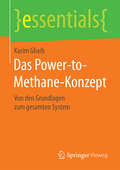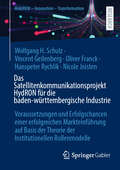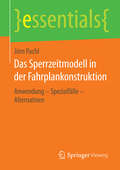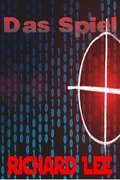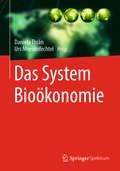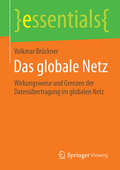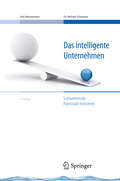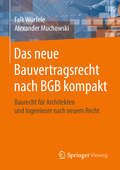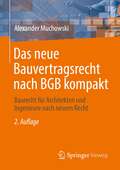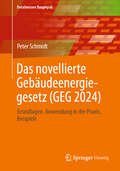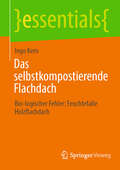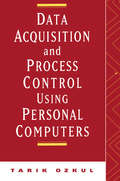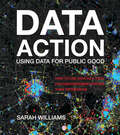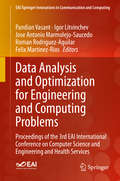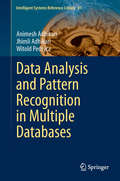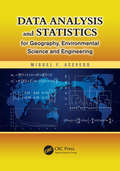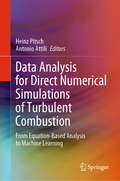- Table View
- List View
Das Power-to-Methane-Konzept: Von den Grundlagen zum gesamten System (essentials)
by Karim GhaibKarim Ghaib stellt hier vor allem die technischen Aspekte des Power-to-Methane-Konzeptes vor. Er geht auf die einzelnen Glieder der Prozesskette im Detail ein, bevor er einige Power-to-Methane-Anlagen zeigt. Mit anschaulichen Grafiken erleichtert der Autor das Verst#65533;ndnis. Ein umfangreiches Literaturverzeichnis erm#65533;glicht es zudem, auch k#65533;nftig schnell auf aktuelle Informationen zugreifen zu k#65533;nnen.
Das Recht der erneuerbaren Energien zur Wärmeversorgung des Gebäudesektors: Rechtliche Prüfung der Rahmenbedingungen des Einsatzes von Wärme aus erneuerbaren Energien in Gebäuden sowie der Weiterentwicklungsmöglichkeiten zur Erfüllung der Klimaschutzziele Deutschlands (Schriftenreihe des Instituts für Klimaschutz, Energie und Mobilität)
by Simon Schäfer-StradowskyDer Doktorarbeit liegt die Arbeitshypothese zugrunde, dass es für das Erreichen der Klimaschutzziele Deutschlands im Gebäudesektor der erfolgreichen Integration erneuerbarer Energien in die Wärmeversorgung von Gebäuden bedarf und hierfür die EE-Wärme-Quote als eines der wesentlichen rechtlichen Instrumente weiterentwickelt werden muss. Der Fokus der vorliegenden rechtlichen Betrachtung liegt dabei auf den Regelungen im GEG zum Einsatz von erneuerbaren Energien in Gebäuden.
Das Satellitenkommunikationsprojekt HydRON für die baden-württembergische Industrie: Voraussetzungen und Erfolgschancen einer erfolgreichen Markteinführung auf Basis der Theorie der Institutionellen Rollenmodelle (Mobilität – Innovation – Transformation)
by Wolfgang H. Schulz Nicole Joisten Vincent Geilenberg Oliver Franck Hanspeter RychlikDie Wettbewerbsfähigkeit der deutschen Volkswirtschaft hängt in besonderem Maße nicht nur von ihrer Innovationskraft ab, sondern auch von der Geschwindigkeit, mit der diese Innovationen zur Marktreife gebracht werden. Dies ist eine entscheidende Voraussetzung, um die ambitionierten Ziele der Digitalen Transformation und der Klimaneutralität (die sog. twin transition) zu erreichen. Hohe Produktivitätssteigerungen, die gleichzeitig neue Wachstumschancen eröffnen, können nur durch kapitalintensive Innovationen realisiert werden. Solche Innovationen erfordern in Deutschland jedoch industrieübergreifende Hyperkooperationen, die diskriminierungsfrei und im Einklang mit wettbewerbsrechtlichen Vorgaben umgesetzt werden müssen. Ein herausragendes Beispiel ist das Projekt HydRON zur laserbasierten Satellitenkommunikation, das als industriepolitisches Vorbild dienen kann. Es zeigt auf, wie durch die Anwendung der Theorie der Institutionellen Rollenmodelle eine Hyperkooperation über verschiedene Industriezweige hinweg erfolgreich gestaltet werden kann.
Das Sperrzeitmodell in der Fahrplankonstruktion: Anwendung – Spezialfälle – Alternativen (essentials)
by Jörn PachlDieses Essential behandelt das spezielle Problem der Modellierung der betrieblichen Inanspruchnahme der Infrastruktur durch Zugfahrten als Voraussetzung für die Ermittlung konfliktfreier Fahrplantrassen in der rechnergestützten Fahrplankonstruktion. Die in den heute am Markt befindlichen Softwarelösungen realisierten Methoden, nämlich das Sperrzeitmodell und die vereinfachte Betrachtung fahrplantechnischer Zugfolgeabschnitte, werden ausführlich erläutert und mit ihren Vor- und Nachteilen gegenübergestellt. Diskutiert werden auch alternative Ansätze und mögliche Weiterentwicklungen.
Das Spiel
by Richard LeeWährend des Urknalls erwacht ein schlafendes Virus und wird sich "bewusst". Sie wandert allein auf der Erde umher, bis sie über Menschen stolpert, die ihr anfangs gefallen haben. Aber die neue Menschenrasse ist klüger und hat weniger Mythen, Träume und Hass. Als Reaktion auf ihre Angst ist die Wanderin in einer Höhle gefangen, während die Eiszeiten näher rücken. Sie verachtet sie. Sie schließt einen Rachepakt mit ihrem Gott, aber er tötet sie stattdessen. Ohne einen Körper kann sie nur zwischen den Welten existieren - bis sie Phillip McKenzie, einen Spieleprogrammierer, trifft. Sie ist völlig angetan von ihm. Ihr einziger Kontakt ist zunächst durch Träume, und wenn er erwacht, erinnert er sich nicht an sie, aber er erinnert sich an die Mathematik, die sie ihm beigebracht hat, und wendet sie auf seine Spiele an. Jahre später, bei der Veröffentlichung seines neuesten und meistgehypten Spiels ... kehrt die Wanderin zurück. Das von ihm geschaffene Spiel ist ihre Heimat geworden, und sie will raus. Sie will wieder auf der Erde wandeln. Allerdings gibt es ein paar Probleme -- Phillip will ihr nicht helfen, und sie ist total in den Kerl verliebt. Aber seine Familie, das ist eine andere Geschichte - sie sind nichts für sie. Und das ist ihr Ass im Ärmel. Lisa vermisst ihren Vater. Ihre Mutter ist ein Junkie auf dem Weg der Besserung, und ihr kleiner Bruder Timmy ist das Beste auf der Welt. Ein Paket und eine unerwartete E-Mail von ihrem Vater kommen bei ihr an und laden sie zum Spiel ein. Sie ist minderjährig, aber sein Exemplar kann dieses kleine Problem überwinden. Der Ex-Dealer / Liebhaber / Zuhälter ihrer Mutter kommt zum Abendessen, und diesmal will er mehr als ihre Mutter, er will auch sie. Um seinen wandernden Augen und seinen Annäherungsversuchen zu entgehen, nimmt Lisa Timmy mit auf ihr Zimmer und lässt ihn sein Lieblingsspiel spielen. Als er den Monitor einschaltet, strömt Maschinencode aus de
Das System Bioökonomie
by Daniela Thrän Urs MoesenfechtelDieses Buch ist eine prägnante Gesamtschau auf den Status Quo der Bioökonomie und ihre zukünftigen Entwicklungen – in Deutschland und darüber hinaus. Zahlreiche Praktikerinnen und Praktiker aus Wirtschaft, Wissenschaft, Zivilgesellschaft und Politik zeigen, wie die Bioökonomie den globalen Problemen der Zukunft begegnet. Auf der Basis nachwachsender Rohstoffe und Energien entwickelt die Bioökonomie neue Produkte und Verfahrensweisen und möchte so eine ökologisch und ökonomisch nachhaltigere Zukunft gestalten. Doch kann ihr das gelingen? Wo liegen ihre Möglichkeiten und Grenzen? Welche Rahmenbedingungen beeinflussen sie? Das Buch beantwortet diese Fragen mit einer systemischen Sicht auf die Bioökonomie und ermöglicht so eine schnelle Orientierung in diesem Thema. Das wird durch zahlreiche Grafiken zusätzlich unterstützt. Somit lädt das Buch dazu ein, die Zukunft der Bioökonomie mitzugestalten.
Das Theater der Elektrizität: Technologie und Spektakel im ausgehenden 19. Jahrhundert (Szene & Horizont. Theaterwissenschaftliche Studien #6)
by Ulf OttoDas Theater der Moderne gründet sich auf ästhetische Energien. Seit den 1880er Jahren aber sind es elektrische Energien, aus fossilen Brennstoffen in Kraftwerken erzeugt, die im Theater zu zirkulieren beginnen. Installiert wird eine mysteriöse Entität, die noch als Lebenskraft gehandelt wird und schon für Fortschritt durch Technik steht. Mit der Elektrifizierung des Theaters wird Elektroindustrie respektabel und Bühnenkunst modernistisch. Entsorgt werden die Kulissen, die im Scheinwerferlicht nur noch verstaubt erscheinen, und aus der Bildermaschine wird Raumkunst. Doch wichtiger sind die institutionellen Transformationen, die sich in bislang unbeachteten Koalitionen, Kontinuitäten und Konkurrenzen von technischen und ästhetischen Dingen abspielen. Ingenieurswissen, Kontrolltechniken und Versorgungssysteme ändern, wie Theater und Gesellschaft verschaltet sind. Der Interaktionsraum (zwischen-)menschlicher Leiblichkeit des 20. Jahrhunderts entpuppt sich als eine technische Konstellation.
Das europäische Luftrecht zur Instandhaltung verstehen und sinnvoll umsetzen: Einführung in den EASA Part 145 und Part CAMO
by Martin Hinsch Robert RichterIn der Instandhaltung von Luftfahrzeugen und deren Komponenten gibt es zahlreiche Vorschriften und Regelungen, die es einzuhalten gilt, um die Sicherheit der Passagiere und Crews sowie des eingesetzten Geräts zu gewährleisten. So nehmen Gesetzgeber und Luftaufsichtsbehörden entscheidenden Einfluss auf Betriebsorganisation, Personalqualifizierung, Managementsystem sowie die Leistungserbringung im Rahmen der luftfahrttechnischen Instandhaltung selbst.Das Buch unterstützt beim Verständnis und bei der betrieblichen Umsetzung der luftrechtlichen Anforderungen an die Instandhaltung nach EASA Part 145 und das Instandhaltungsmanagement nach EASA Part CAMO. Nach einer Heranführung an den Aufbau und die Struktur des europäischen Luftrechts im Allgemeinen wird im Speziellen auf den EASA Part 145 sowie den Part CAMO inklusive des Part M eingegangen. Das Buch richtet den Blickwinkel vor allem auf die Erläuterung und die Übersetzung der Durchführungsverordnung in die Sprache des betrieblichen Alltags. Dabei werden auch die Umsetzungsvorgaben aus Guidance Material und den AMCs im Detail berücksichtigt. Praxishinweise und Empfehlungen erleichtern das Verständnis und die Umsetzung im eigenen Unternehmen.Der Aufbau des Buchs orientiert sich an der Struktur des relevanten Regelwerks. Die Anforderungen zum Safety-Management werden in einem eigenen Kapitel erklärt.
Das globale Netz: Wirkungsweise und Grenzen der Datenübertragung im globalen Netz (essentials)
by Volkmar BrücknerVolkmar Brückner gibt einen Überblick über die Datenübertragung im Festnetz, durch Mobilfunk oder Satelliten sowie über globale mobile und optische Netze. Grenzen und Fehlerquellen für das Festnetz und die Übertragung bei der mobilen Kommunikation sowie Problemfelder in Technik und Ökologie werden angesprochen.
Das gute Webinar: Das ganze Know How für bessere Online-Präsentationen, ein Praxisratgeber: Online präsentieren und Kunden gewinnen (X.media.press)
by Anita Hermann-Ruess Max OttIn diesem Buch lernen Sie anschaulich und praxisnah, wie Sie ein gutes Webinar organisieren, produzieren und live durchführen.Sie erhalten Antworten auf die Fragen: Was sind Webinare überhaupt? Wie können Sie das Format „Webinar“ in Ihrem Unternehmen sinnvoll einsetzen? Welche Technik benötigen Sie für gute Webinare? Wie produzieren Sie Präsentationen onlinegerecht? Wie halten Sie ein Webinar überzeugend und fesselnd live? Wie nutzen andere Unternehmen und Organisationen dieses Format heute schon erfolgreich?Sechs Kapitel führen Sie in die Welt der Webinare ein mit vielen Materialien, Checklisten, Plänen und Inspirationshilfen. Auf einer extra Website zum Buch erhalten Sie die wichtigsten Vorlagen zum Herunterladen, ein Bonuskapitel zum Thema Onlinemarketing, Beispiel-Webinare zum Anschauen und viele weitere Informationen.
Das intelligente Unternehmen: Schlummernde Potenziale realisieren (VDI-Buch)
by Michael Schwarzer Otto WassermannDer Berater Otto Wassermann folgt mit seinem Team einer Philosophie, die auf reiner Logik basiert und Mitarbeiter aktiv mit einbezieht. Nach dieser Philosophie ist ein Unternehmen ein System, das wie jedes System seine Schwachstellen hat. Und niemand kennt Wassermann zufolge die Schwachstellen und auch die Wege zu ihrer hocheffizienten Beseitigung besser als die Mitarbeiter. Der Band bietet eine fundierte Einführung in die Unternehmensphilosophie und zeigt praxisbewährte Wege auf, wie dieses Potenzial der Mitarbeiter zu aktivieren ist.
Das kreative Volumen: Wie Designer kreativen Freiraum für Rezipienten interaktiver Produkte schaffen
by Jörg Burbach Nadine TrautzschWie weit kann ein Spiel gehen, um uns in seine Welt eintauchen zu lassen? Das theoretische Modell des Kreativen Volumens betrachtet dazu alle narrativen und ludischen Elemente in ihrer Gesamtheit. Dieses Konzept lässt sich auf das Entwickeln und Erleben von Videospielen anwenden, indem es nicht nur Immersion und Einfühlung, sondern auch die subtile Kunst des Weglassens betont. Das Buch vereint disziplinübergreifende Ansätze, um kreative Prozesse sowohl auf Seiten der Entwickler:innen als auch der Spieler:innen zu fördern. Kern des Modells sind die drei Dimensionen: Kreatives Fundament (durch die Entwickler:innen gestaltete Elemente), Kreatives Potenzial (die schöpferische Interaktion der Spieler:innen) und Kreative Resonanz (Auswirkungen des Spiels über dessen Grenzen hinaus).Es bietet praxisorientierte Leitlinien, wie gestalterische Entscheidungen die emotionale, narrative und soziale Interaktion im Spiel formen können. Es zeigt auf, wie durch bewusste Gestaltung Freiräume für kreative Entfaltung geschaffen und reflektiert werden können und wir somit Spiele zu kulturellen Artefakten und Resonanzräumen entwickeln können. Mit Blick auf die zunehmende Komplexität interaktiver Produkte schafft das kreative Volumen ein Vokabular und einen Rahmen, um Spielentwicklung strategischer, wirkungsvoller und inspirierender zu gestalten. Die Zielgruppe umfasst Game Designer:innen, Entwickler:innen, Künstler:innen und Forscher:innen, die ihr Verständnis von kreativer Interaktivität vertiefen und die gestalterische Praxis auf ein neues Level heben möchten. Begleitmaterial unter https://www.kreatives-volumen.de
Das menschliche Büro - The human(e) office: Hilfe zur Selbsthilfe für eine gesunde Arbeitswelt - Helping people to a healthy working environment
by Christine KohlertDie neuen Arbeitswelten können aus ganz unterschiedlichen Perspektiven betrachtet werden. Für die einen erscheint alles positiv, für die anderen negativ. Aber was bedeuten diese neuen Arbeitswelten für die Mitarbeiterin und Mitarbeiter? Wie kann man sich dort am besten zurechtfinden? Was können die Mitarbeiterin und Mitarbeiter persönlich dazu beitragen, in einer gesunden Bürowelt zu arbeiten und dabei zufrieden und glücklich zu bleiben? Das Buch analysiert Arbeitswelten und gibt Hilfestellungen sowohl in der Planungsphase wie auch im Bestand. Darüber hinaus unterstützt es Menschen dabei, das Richtige in ihrem Berufsalltag zu tun und sich selbst zu helfen, in einer positiven Atmosphäre zu arbeiten. Gemeinsam mit verschiedenen Autoren aus unterschiedlichen Professionen geht die Herausgeberin in diesem Buch der Frage nach, was ein Büro menschlich macht und was die unterschiedlichen Interessengruppen zu einer humanen Arbeitsumgebung beitragen können.
Das neue Bauvertragsrecht nach BGB kompakt: Baurecht für Architekten und Ingenieure nach neuem Recht
by Falk Würfele Alexander MuchowskiAb 2018 gilt das neue Bauvertragsrechts im BGB für alle neu geschlossenen Verträge nach dem 1. Januar 2018. Hierfür wurden die Paragraphen 631-651 BGB, die das Werkvertragsrecht im BGB regeln, ergänzt und überarbeitet. Die Reform betrifft sowohl Bauverträge als auch das Architekten- und Ingenieur-Recht.Dieses Fachbuch erläutert den am Bau Beteiligten anschaulich die neue Reform und gibt Hilfestellungen für die Anwendung in der Praxis.
Das neue Bauvertragsrecht nach BGB kompakt: Baurecht für Architekten und Ingenieure nach neuem Recht
by Alexander MuchowskiDieses Fachbuch erläutert den am Bau Beteiligten anschaulich die Reform des Bauvertragsrechts aus 2018 und gibt Hilfestellungen für die Anwendung in der Praxis. Seit 2018 gilt das neue Bauvertragsrechts im BGB für alle neu geschlossenen Verträge. Hierfür wurden die Paragraphen 631-651 BGB, die das Werkvertragsrecht im BGB regeln, ergänzt und überarbeitet. Die Reform betrifft sowohl Bauverträge als auch das Architekten- und Ingenieur-Recht.Die 2. überarbeitete Auflage berücksichtigt die Erkenntnisse seit dem Inkrafttreten der Reform.
Das novellierte Gebäudeenergiegesetz: Grundlagen. Anwendung in der Praxis, Beispiele (Detailwissen Bauphysik)
by Peter SchmidtDieses Lehrbuch gibt sowohl Studierenden als auch Praktikern eine grundlegende Einführung in das novellierte Gebäudeenergiegesetz (GEG), umgangssprachlich auch Heizungsgesetz genannt, in der Fassung 2024. Nach einem allgemeinen Teil mit Anwendungsbereich und wichtigen Begriffsdefinitionen werden die Anforderungen an Neubauten und bestehende Gebäude, an Anlagen der Heizungs-, Kühl- und Raumlufttechnik sowie der Warmwasserversorgung behandelt. In diesem Zusammenhang werden die verschiedenen Nachweise (z. B. Referenzgebäudeverfahren, Bauteilverfahren) beschrieben und an Beispielen erläutert. Sofern erforderlich, wird hierbei auch auf die benötigten Regelwerke (z. B. Normen zum Wärmeschutz und zur energetischen Bewertung von Gebäuden) eingegangen. Außerdem werden die verschiedenen Anlagenkomponenten und ihre Funktionsweise erläutert. Den Abschluss bilden Beiträge zum Energieausweis sowie zu sonstigen Vorschriften (Vollzug desGesetzes, Übergangsvorschriften usw.). Neben vielen Beispielen mit Lösungsweg unterstützen zahlreiche Aufgaben und Fragen mit Lösungen beim Selbststudium und der Prüfungsvorbereitung.
Das selbstkompostierende Flachdach: Bio-logischer Fehler: Feuchtefalle Holzflachdach (essentials)
by Ingo KernDie energetischen Anforderungen beim Hausbau sind in den letzten Jahren gestiegen. Daher werden Holzflachdächer häufig mit immer dickeren Dämmstoffschichten ausgestattet und der komplette Hohlraum in der Sparrenebene ausgefüllt. In den letzten Jahren sind vermehrt Schäden an Holzflachdächern mit Dämmung in der Tragwerksebene aufgetreten. Dieses essential zeigt die Ursachen auf und gibt Hinweise zum Umgang mit der sensiblen Konstruktion.
Das Öffentliche und das Private: Informationstechnologische Entwicklungen und deren Einfluss auf öffentliches und privates Leben (Die blaue Stunde der Informatik)
by Wolfgang OsterhageTechnologische Entwicklungen beeinflussen öffentliches Leben in Politik und Wirtschaft, aber auch unser eigenes, privates Dasein. Gewollt oder ungewollt kommen wir täglich – und sogar des Nachts, wenn wir schlafen – mit Technologien in Berührung, die wir selbst nur bedingt kontrollieren können oder wollen. Es gibt keine Lebenslage, in denen eine Berührung mit elektronischen Systemen nicht gegeben ist. Insofern hat die Menschheit ihre informatorische Unschuld für immer verloren, bis hin zum Missbrauch persönlichen Identitäten in sozialen Netzen, in denen ein Leben in Scheinidentitäten stattzufinden scheint. Information und Kommunikation sind Wirtschaftsfaktoren geworden, die am Ende des Industriezeitalters und am Beginn des Wissenszeitalters zu stehen scheinen. Das technisch Hergestellte wird dem Organischen immer ähnlicher. Natur und Maschinen verschmelzen und entziehen sich unserer Kontrolle. Man tut, was dem System nutzt. Das Leben wird zu einer Risiko- und Wahrscheinlichkeitsrechnung, und das Ich nur noch zu einem Interface.
Data Acquisition Systems: From Fundamentals to Applied Design
by Maurizio Di Paolo EmilioThis book describes the fundamentals of data acquisition systems, how they enable users to sample signals that measure real physical conditions and convert the resulting samples into digital, numeric values that can be analyzed by a computer. The author takes a problem-solving approach to data acquisition, providing the tools engineers need to use the concepts introduced. Coverage includes sensors that convert physical parameters to electrical signals, signal conditioning circuitry to convert sensor signals into a form that can be converted to digital values and analog-to-digital converters, which convert conditioned sensor signals to digital values. Readers will benefit from the hands-on approach, culminating with data acquisition projects, including hardware and software needed to build data acquisition systems.
Data Acquisition and Process Control Using Personal Computers
by Ozkul""Covers all areas of computer-based data acquisition--from basic concepts to the most recent technical developments--without the burden of long theoretical derivations and proofs. Offers practical, solution-oriented design examples and real-life case studies in each chapter and furnishes valuable selection guides for specific types of hardware.
Data Action: Using Data for Public Good
by Sarah WilliamsHow to use data as a tool for empowerment rather than oppression.Big data can be used for good--from tracking disease to exposing human rights violations--and for bad--implementing surveillance and control. Data inevitably represents the ideologies of those who control its use; data analytics and algorithms too often exclude women, the poor, and ethnic groups. In Data Action, Sarah Williams provides a guide for working with data in more ethical and responsible ways. Too often data has been used--and manipulated--to make policy decisions without much stakeholder input. Williams outlines a method that emphasizes collaboration among data scientists, policy experts, data designers, and the public. This approach creates trust and co-ownership in the data by opening the process to those who know the issues best.
Data Analysis and Optimization for Engineering and Computing Problems: Proceedings of the 3rd EAI International Conference on Computer Science and Engineering and Health Services (EAI/Springer Innovations in Communication and Computing)
by Pandian Vasant Igor Litvinchev Jose Antonio Marmolejo-Saucedo Roman Rodriguez-Aguilar Felix Martinez-RiosThis book presents the proceedings of The EAI International Conference on Computer Science: Applications in Engineering and Health Services (COMPSE 2019). The conference highlighted the latest research innovations and applications of algorithms designed for optimization applications within the fields of Science, Computer Science, Engineering, Information Technology, Management, Finance and Economics and Health Systems. Focusing on a variety of methods and systems as well as practical examples, this conference is a significant resource for post graduate-level students, decision makers, and researchers in both public and private sectors who are seeking research-based methods for modelling uncertain and unpredictable real-world problems.
Data Analysis and Pattern Recognition in Multiple Databases (Intelligent Systems Reference Library #61)
by Witold Pedrycz Animesh Adhikari Jhimli AdhikariPattern recognition in data is a well known classical problem that falls under the ambit of data analysis. As we need to handle different data, the nature of patterns, their recognition and the types of data analyses are bound to change. Since the number of data collection channels increases in the recent time and becomes more diversified, many real-world data mining tasks can easily acquire multiple databases from various sources. In these cases, data mining becomes more challenging for several essential reasons. We may encounter sensitive data originating from different sources - those cannot be amalgamated. Even if we are allowed to place different data together, we are certainly not able to analyze them when local identities of patterns are required to be retained. Thus, pattern recognition in multiple databases gives rise to a suite of new, challenging problems different from those encountered before. Association rule mining, global pattern discovery and mining patterns of select items provide different patterns discovery techniques in multiple data sources. Some interesting item-based data analyses are also covered in this book. Interesting patterns, such as exceptional patterns, icebergs and periodic patterns have been recently reported. The book presents a thorough influence analysis between items in time-stamped databases. The recent research on mining multiple related databases is covered while some previous contributions to the area are highlighted and contrasted with the most recent developments.
Data Analysis and Statistics for Geography, Environmental Science, and Engineering
by Miguel F. AcevedoProviding a solid foundation for twenty-first-century scientists and engineers, Data Analysis and Statistics for Geography, Environmental Science, and Engineering guides readers in learning quantitative methodology, including how to implement data analysis methods using open-source software. Given the importance of interdisciplinary work in sustain
Data Analysis for Direct Numerical Simulations of Turbulent Combustion: From Equation-Based Analysis to Machine Learning
by Heinz Pitsch Antonio AttiliThis book presents methodologies for analysing large data sets produced by the direct numerical simulation (DNS) of turbulence and combustion. It describes the development of models that can be used to analyse large eddy simulations, and highlights both the most common techniques and newly emerging ones. The chapters, written by internationally respected experts, invite readers to consider DNS of turbulence and combustion from a formal, data-driven standpoint, rather than one led by experience and intuition. This perspective allows readers to recognise the shortcomings of existing models, with the ultimate goal of quantifying and reducing model-based uncertainty. In addition, recent advances in machine learning and statistical inferences offer new insights on the interpretation of DNS data. The book will especially benefit graduate-level students and researchers in mechanical and aerospace engineering, e.g. those with an interest in general fluid mechanics, applied mathematics, and the environmental and atmospheric sciences.
